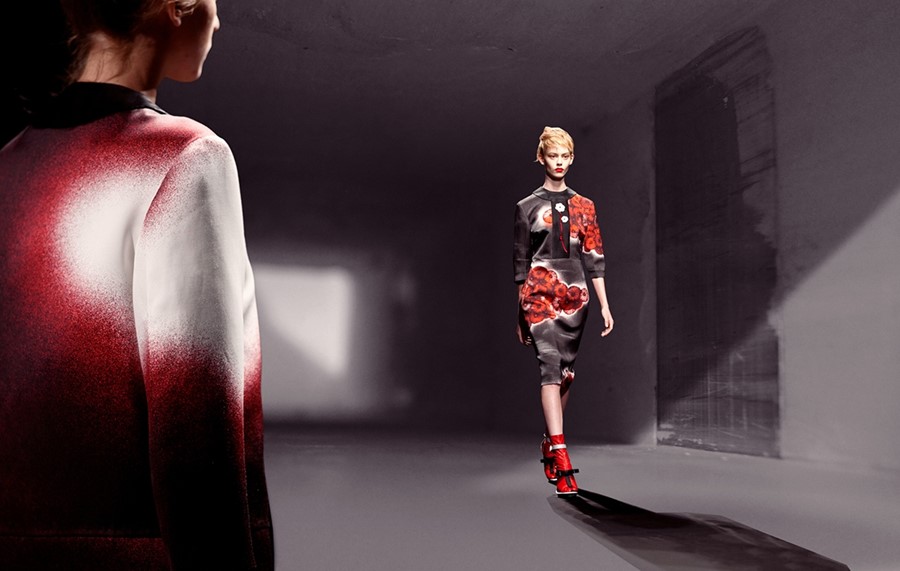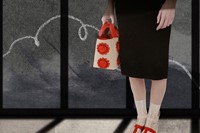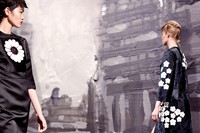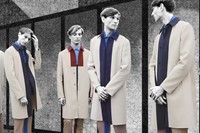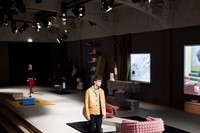“In an ideal home, nothing you do can go wrong” once cooed the British doom-mongerers of pop, Black Box Recorder. Watching the A/W13 Prada men’s show, you could almost hear the delicious irony of those lyrics....
“In an ideal home, nothing you do can go wrong” once cooed the British doom-mongerers of pop, Black Box Recorder. Watching the A/W13 Prada men’s show, you could almost hear the delicious irony of those lyrics reverberate through the Prada Fondazione. Inverting the traditional configuration of a catwalk show, the audience was seated on an irregularly shaped central island facing a set conceived by AMO, the division of Rem Koolhaas’ thinktank OMA who have been working with Prada since 2004. There, the audience was confronted by manifestations of an “ideal house” – projections of interiors and furniture (a range for Knoll that just launched at Salone Del Mobile) that turned the models into characters weaving through scenes of domestic life. “Miuccia has some obsessions that are related to her education and her history,” confirms AMO’s architect Ippolito Pestellini, who heads up the Prada catwalk collaboration. “One of them is with the bourgeoisie, specifically in a Milanese context of the 60s-70s. We looked into many movies from Antonioni and Godard – there were very impressive interiors where those movies were taking place.” Things then took a darker turn at the women’s show, with AMO creating an industrial, abandoned environment lit by shadows to tell a different story: this time a sinister fable of noirish femme fatales, that was according to Pestellini, “a different 3-D movie, this time influenced by Hitchcock and ‘9 1/2 Weeks.’”
"Things took a darker turn at the women’s show, with AMO creating an industrial, abandoned environment lit by shadows to tell...a sinister fable of noirish femme fatales"
Each season AMO transform the Fondazione Prada in Milan, often in ways that dispense with the traditional hierarchies of fashion shows. “For us designing a catwalk is almost like designing a temporary public space,” Pestellini says. “You have to seat 700 people for 12 minutes in an interesting and different way.” Unusually, work begins on the set virtually in parallel with the design of the collection, so “each one amplifies each other. We create a concept both geometrically or through scenography that they can react to. It’s not so far away from theatre in the way the costumes are a function to the overall concept.” The final stage of the collection is the lookbook AMO produce for Prada every season – “They represent what happens during the show, expressed through graphics which is a more direct means of expression." While AMO’s early work for Prada dealt in extreme spatial concepts, their focus has recently shifted to more scenographic elements. Think of 50s custom cars for S/S12 womenswear or the star-studded cast of actors for the A/W12 men’s show that referenced Soviet architecture. Pestellini agrees, “With the recent shows, it’s more similar to set design. The spatial transformation is maybe more limited, it’s slightly less radical in terms of organisation but the experience is still very strong, we’ve just shifted the tension to another domain of investigation.”
Few partnerships then have been as groundbreaking as that between Prada and Koolhaas – both revel in completely twisting expectations and preconceived notions in their work. “There’s always the intention to wrongfoot the visitors,” says Pestellini, “To make something not completely clear or evident at first glance.” He sees a synergy in the way they both operate: “It’s very conceptual at the beginning and that’s why the results are always so different. Prada and AMO work in a similar way: everything starts from research. It’s about a concept that emerges in multiple configurations. There’s not really a method – it’s always a surprise.”
Text by Kin Woo
